La Disparition
Photographies -
De la Communaute Francaise de Belgique -
de Pologne -
du Québec.
Jocelyne Alloucherie, Patrick Altman, Blow Up, Eve Cadieux, Ronald Dagonnier, Charles Guilbert, Tomasz Konart, Natalia LL, Cecile Michel, Roberto Pellegrinuzzi, Anna Penders, Pol Pierart, Wojciech Pra¿mowski,Nicolas Renaud, Jean-Louis Vanesch, Stanis³aw J.Wo¶.
January 16 – February 15, 2004
Opening: January 16th, 2004, 7.30 pm
Hall de la Salle Multi de la cooperative Méduse
591, rue De Saint-Valier Est, Québec

"Desktrukty", Natalia LL's exhibition at VU Centre, Québec City, as part of "Disappearance" project, 2004. Photo by M. Grygiel
"Disappearance" - for the third time
 |
THE artistic project that was born in Belgium in the Cultural Centre "Les Chiroux" has lasted for three years. Its premiere took place during the Biennial of Photography and Visual Arts in Liege on February 14th, 2002. The next presentation was held in the Centre for Contemporary Art in Warsaw (January 6th, 2003). FOTOTAPETA reported on these two events. *
Now is the time to report on the last act which took place on January 16th, 2004 in the far away city of Québec, the capital of a Canadian Province of the same name.
VU, Centre de diffusion et de production de la photographie - what may be understood as 'the centre of production and propagation of photography' - the Canadian co-organizer of the exhibition, has its premises in the cultural complex Méduse. It is long series of buildings fitted closely between two streets: Cote d'Abraham and St Valier. Besides VU that has there two exhibition spaces, darkrooms and workrooms there are also other cultural institutions, e.g. L'oeil de Poisson which is interested in visual arts in a broader sense, Engramme - visual arts workshops, La Bande Video - film animation and even a workshop called Heavy Metal that happens to be a studio of artistic smithery. All these gathered under one roof institutions constituted a part of this comprehensive presentation. There should be mentioned also a spacious exhibition room of the Laval University and the Rouje, an alternative club presenting art events on the St. Joseph Street.
Such stratification of the exhibition consisting of works of more than dozen artists from three countries can be considered to be risky move but in Québec this move proved to be the right one. Some artists were given separate rooms what helped to perceive their presentations more like individual shows. It was particularly the case of Natalia LL, who presented her "Destructions" - seven photographic works on canvas and of Stanislaw J. Wos for whom the organizers prepared the so called "Espace europenne", a small square room the size of the Mala Gallery in Warsaw. His pictures viewed directly without glass before them and lit with dimmed light became more mystic in perception.

"Desktrukty", Natalia LL's exhibition at VU Centre, Québec, as part of "Disappearance" project, 2004. Photo by M. Grygiel
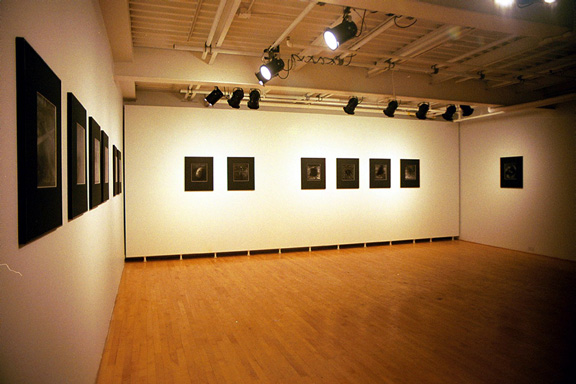
Stanislaw J. Wos' series "From Darkness and Light" in "European Space" gallery at VU Centre, Québec, as part of "Disappearance" project, Jan-Feb'04. Photo by M. Grygiel
 Map of galleries participating in "Disappearance" project in Quebec City (PC): (1) VU - cooperative Méduse, (5) klub Rouje, (6) Laval University Laval Visual Arts Gallery. |
The other two Polish artists were deliberately juxtaposed with artists who were in a way carrying a dialogue with them - through form and content of their works. Tomasz Konart with his interactive installation "Brothers and Sisters" was confronted with huge panorama and video presentation of Ronald Dagonnier from Belgium in a sterile white show room of the Laval University and Wojciech Prazmowski with his works from the "Family Album", "Honeymoon" and "Hommage a ..." series and photographic objects was dialoguing with big sized solarisations of Eve Cadieux and small black and white works of Jean Louis Vanesch in the space of the alternative club Rouje.
Some artists, like was also in Warsaw, took opportunity of the new exhibition space to introduce some complementing or totally new works. In Warsaw it was the case of Wojciech Prazmowski who presented series of light boxes "Time Reconstructions", in Québec it was a Canadian Roberto Pelegrinuzzi who in small space of the Engramme Gallery showed his new work "Revelations" - a kind of an installation consisting of hundreds of fragments of photographs from family archives cut into tiny pieces - a symbol of passing time, impossibility to preserve memories in any durable form, elusiveness of photographic records on something so impermanent as paper.
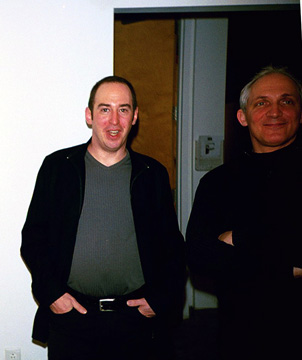 Co-authors of the "Disappearance" project: André Gilbert, director of VU Centre, Québec, and Lucien Barel, director of Centre „Les Chiroux” in Liege, Belgium. Photo by M. Grygiel. |
Next day after opening evening there was an interesting symposium at the Laval University during which the idea of "disappearance" in photography was discussed more extensively.
Historic sources of this phenomenon were reminded by Pierre Dessureault from the Canadian Museum of Contemporary Photography, Andre Gilbert, the director of VU talked shortly about origins of the whole project and about works of the artists participating in the exhibition "Disparition". Marek Grygiel presented other contemporary Polish artists who in their works relate to phenomenon of "disappearance" in photography. The two of artists participating in this project - Canadian Charles Guilbert and Belgian Ronald Dagonnier presented their other realizations related to this problem.
The audience was strongly stirred by performance of Charles Guilbert, an artist who is not a photographer (writer, poet, illustrator) and who was singing a capella one of his lyrical poems.
The project "Disappearance" caused - what emphasized during his opening speech Lucien Barel, the director of the Centre "Les Chiroux" in Liege - an interesting confrontation with the phenomenon that is fundamental to the photographic medium. This confrontation was manifested not only through a wide range of presented technologies, from classical photographs to various kinds of special techniques as solarisation, multiple exposures, sandwiching two or more negatives, video, three dimensional photographic objects, slide projections, installations, Internet but also in form of art meeting and creative dialogue of artists from the three, quite distant countries with different histories and ways of development.
The Project "Disappearance" fits well into tradition of artistic exchange which helps us to understand the world more openly and widely.
mg
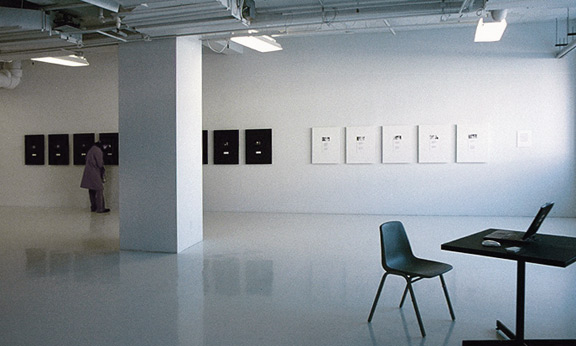
"Disappearance" project in Québec: Tomasz Konart's exhibition in Laval University's gallery. Photo by M. Grygiel.

"Disappearance" project in Québec, visual arts gallery at Laval University, Québec: "Disparition Pyramides" by Ronald Dagonnier. Photo by M. Grygiel
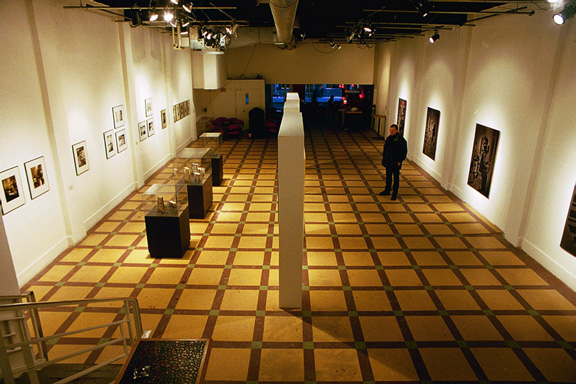
Rouje gallery, Québec - on left: photography works and objects by Wojciech Prazmowski, on right - works by Eve Cadieux. Photo by M. Grygiel
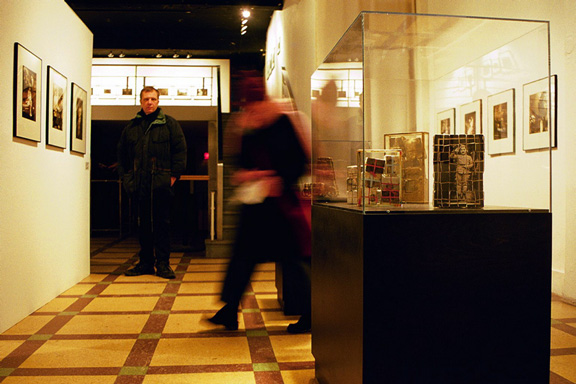
Rouje gallery, Québec: in front - works by Wojciech Prazmowski; on the back, upstairs: exhibition by Jean Louis Vanesch. Photo by M. Grygiel

Québec City as seen from the south shore of St Lawrence River, January 2004. Photo by M. Grygiel.
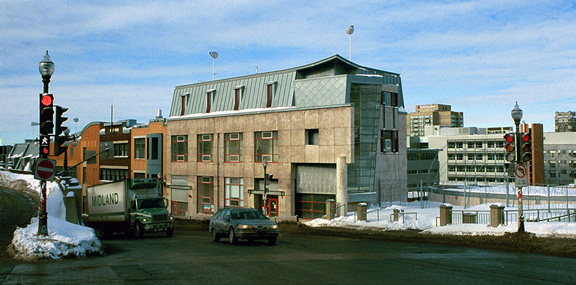
VU Centre is an important part of the Méduse complex. Photo by M. Grygiel.
See also:
- VU, CENTRE DE DIFFUSION ET DE PRODUCTION DE LA PHOTOGRAPHIE
- Méduse - contemporary arts production and performance collective
- La Disparation" - programme (PDF, 247 kB)
Previously in FOTOTAPETA:
- "La Disparition" project premiere as part of 3. Biennale de Liege, Belgium (2002)
- "La Disparition" project at Zamek Ujazdowski Centre for Contemporary Art in Warsaw, Poland (2003)
Copyright © 1997-2025 Marek Grygiel / Copyright for www edition © 1997-2025 Zeta-Media Inc.